Have a look at this one; it would have to be amongst the most colourful of any insect. Its name is Polyzosteria mitchelli, but is generally known (along with many other species) as a Bush Cockroach from the family Blattidae. It grows to around 5 cm in length.
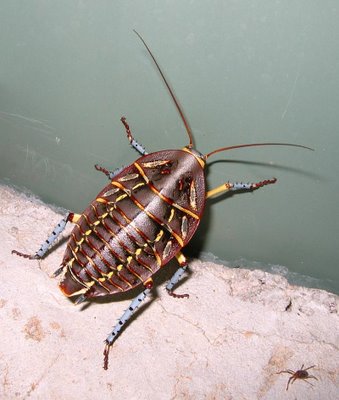
Bush Cockroach, Polyzosteria mitchelli
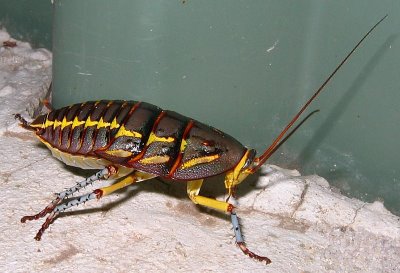
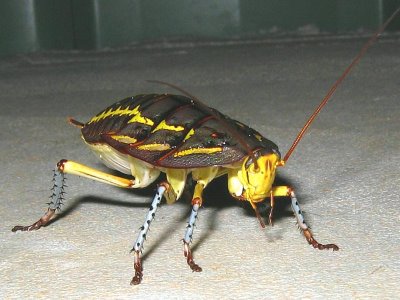

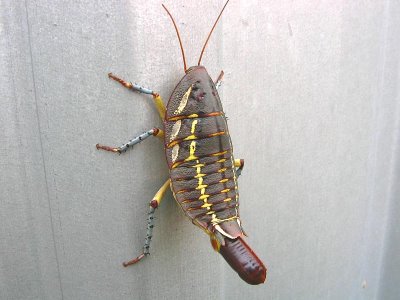

This Platyzosteria species is seldom more than 3 cm in length and can be found at night, quite high in trees where it seeks out flowers on which it feeds. It is also found on the ground and probably is a common prey species for mammals, frogs, reptiles, arachnids and night birds. In defence, many species including this one, will raise up their rear and release a foul smelling concoction to deter any predator with a sensitive nose.

Being completely black, it can play the part of Darth Vader very convincingly.

A Cockroaches life however is not all fun and games, as they have parasites that can be fatal, one of these is the Gordian worm belonging to phylum, Nematomorpha. The adult worms intend leaving their host near water so they can breed and provide habitat for their aquatic young. However, as can be seen with this one, the host is not always cooperative and the worm also dies. (My thanks to the Australian Museum for this information)
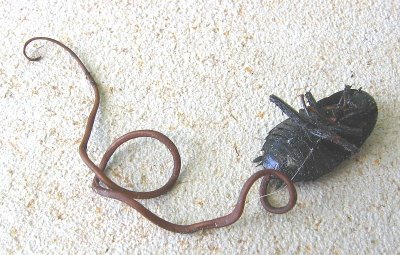
This next species (also from the family Blattidae) can easily be confused with the black variety above (similar looking cockroach species can only be distinguished by their genitalia). However, this species was reasonable distinctive, being a dark bronze in colour, slightly smaller, with shorter leg spines and a pale horseshoe shaped area along the upper shield edge.
This pair are intent on making a large ootheca full of viable eggs. Note the small one (probably the male) compared to the much larger female. Dimorphism and other differences are not unusual with cockroaches and some males and females have in the past been described as different species.
This lady having made her ootheca, is looking for a good spot to place it. Note how fat these animals are, quite unlike the introduced cockroaches, which tend to be flat with both sexes winged.
Yet another cockroach from the Blattidae (this family by the way, is the largest of the five Australian cockroach families, having as many species as the other four families put together). This one is a Drymaplaneta species, or a Bark Cockroach and has a prominent creamy/white horseshoe marking on the shield.
Although having no wings, it is a very good climber (here on glass).

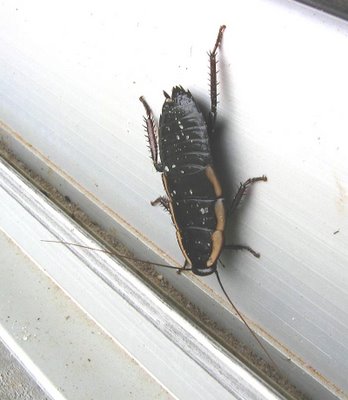
This is a juvenile Blattodea species typically feeding from a Banksia speciosa flower.
Now for a different family! It includes the largest (to 7 cm) and most bulky cockroach in the world and lives here in north Queensland, it is a member of the Blaberidae family. However, this Esperance WA species is much smaller, being less than half that size, but it has the characteristic broad, bulky shape and short legs. These are social animals and raise their young in underground chambers, or under leaf litter, in rotten logs, or dead Grasstrees (Xanthorrhoea sp.) and because of their shape, are commonly known as Trilobite Roaches. The males of these Calolampra species are usually winged, yet they all live together in communities with the females and the young, apparently communicating with each other by scent.

This group with the large, more heavily armoured outer shield, which combined with shorter legs (ideal for digging) are a much slower moving cockroach than most people are familiar with. They probably move around less too, so are not commonly seen unless you happen to be near their nest.
And who could resist this shy modest Trilobite Roach?
 So remember, all roaches, ain't just roaches, particularly when they're native roaches.
So remember, all roaches, ain't just roaches, particularly when they're native roaches.


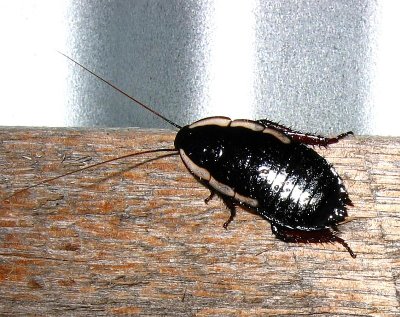

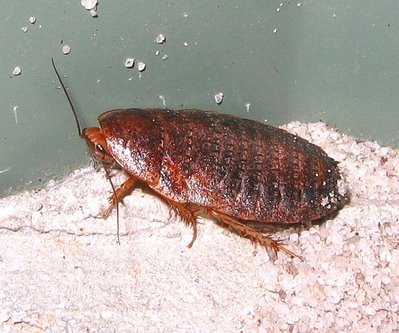
14 comments:
Hi, and thanks for this informative and cockroach-humanising article: you have not quite turned me into a cockroach lover, but you have taught me that it's wrong to think that "a roach is a roach is a roach". In my backyard (Southern Beachside of Sydney), when lifting wooden furniture or such, I have often seen quite a number of what you call the "Bark Cockroach" (with those prominent creamy/white horseshoe markings you mention) scuttling away with the speed of disturbed burglars. (How do they know that they are not wanted?...)
I also did not know that those "sacks" I often find, were containing their eggs.
I find that cockroaches have a strong (and unpleasant) smell - at least the ones that get into the house - and as soon as I become aware of it, I deposit those cockroach bites, nor can I see myself discontinuing with that, but I dont really know why I am so fearful of cockroaches - is it sheer unwarranted prejudice, or are they really carriers of nasty illnesses?
Anyway, keep up the good work. Did you take those photos yourself?
Cheers
PS: I wonder why we call some cockroaches "German Cockroaches" - I dont think there are cockroaches in Germany, it would be too cold I'd think....
Hi missanthropist,
I feel pleased that I may have made a cocky convert. :)
Do those Bark Cockroaches enter your house, or are they only the German ones that do?
A reference of mine says this about the German Cockroach, Blattella germanica. "In Germany it is called the 'Russian cockroach'; in Russia, 'the German'; and is most likely to have originated in Asia." So there you have it, nobody wants to claim it.
Regards
Jack West.
I feel pleased that I may have made a cocky convert. :)
Coming from the land of Bambi, I will yet have to progress quite a bit, before I would cosy up to a cockroach, but you have certainly challenged my prejudices. Your whole blog, incidentally, seems to be a pladoyer for the not so cute'n'cuddly animals(*), and good on you!
Do those Bark Cockroaches enter your house, or are they only the German ones that do?
No, I have only seen the Bark Cockroaches outside, when I lift wooden verandah/garden furniture, only the "german" ones and those huge, flat, brown, flying ones, and some big redish-black ones come into the house. As soon as I see them, I turn into the "grim reaper" with the seemingly very efficient "Lure'n'Kill" Mortein Cockroach Baits. I hate the idea, but, what can one do...they ARE carriers of illness, aren't they?
People say that "bush cockroaches" are "cleaner" than the domestic ones - but I dont know what that really means...
... Blattella germanica. "In Germany it is called the 'Russian cockroach'; in Russia, 'the German'; and is most likely to have originated in Asia." So there you have it, nobody wants to claim it...
hehehe - reminds me of the colloquial names given to condoms:
In Germany they are called "Pariser" (Parisians), in France they call them "capotes anglaises" (english raincoats), and the english reciprocate by calling them "French letters".
(*)with the exception of your terminally cute "moaning frog"
Hi again MissAnthropist, good to hear that the (cute) native cockroach species do not enter your house, unlike the (nasty) introduced ones. Just gos to show what fine fellows they are. :)
>>"german" ones and those huge, flat, brown, flying ones, and some big redish-black ones come into the house.<<
These sound like another couple of introduced roach species, the American and/or the Australian Cockroach. The latter's origin being Asian, so another German/Russian syndrome, although in this case we go along with the joke.
You seem to be living in a roach paradise MissAnthropist, although from a refined roach perspective, you should be living outside. :)
Regards
Jack
could you give a clearer explanation as to why both the native roach and gordian worm both died...thanks from very interested
also wanted to ask if there is an introduced roach that doesnt have wings..or is this a type of native I have here..I have been searching for pics of roaches to id and your site is the most informative,,thanks very interested
Hi Anonymous,
The extract below describes the general process, but I suggest you read the entire link below, as it explains the relationship in detail that will probably make you wonder of the complicated lifestyles of some animals. The outcomes (like in the blog) are far from being reliable either.
>>A larva lives in the body cavity of its host, secreting digestive enzymes through its skin to gradually absorb the host's body contents. It grows and sheds its larval structures, such as the hooks and stylets of the proboscis, and gradually changes its skin to that of an adult. Larval development takes a number of weeks, or even months, during which time the contents of the host's abdomen are completely consumed and the larva completely fills the cavity. It then breaks out when the host is near water, and takes up a free-living existence until its sex organs mature.<<
http://www.amonline.net.au/factsheets/gordian_worms.htm
There is an introduced cockroach without wings (actually greatly reduced), that being the female German Cockroach, Blattella germanica. The male however is winged!
The other common introduced roach is the American Cockroach, Periplaneta americana. These are the large, fully winged, shiny red ones.
Thanks for the photos - someone on ScribblyGum (the ABC science forum) alerted me to your pic of the yellow bellied cockroach when I was trying to identify the one I found on our house in Bridgetown (WA) the other day. See the photo here: http://outdoors.webshots.com/photo/2812716900045721055cwdJSa
I'm not sure that 'mine' is the Polyzosteria mitchelli as it's nowhere NEAR as colourful as yours. It's now somewhere in the garden living its life, so I can't even go check it out any more.
Great photos!
Hi Rhonda, you have a very attractive bush cockroach and one I am not familiar with. It certainly looks like a member of the family Blattidae and very likely one of the Polyzosteria species, but which one, I have no idea. To id cockroaches the genitalia needs microscopic examination, so not possible from a photograph. It is also possible that it is one of the nymphs which can vary considerably between morphs.
If you want a more positive identification you could try the Australian Museum (one of my links). They are very helpful and have many resources to help with identification.
If you can pin it down, I would be most interested in its identification, so would appreciate it if you would get back to me with any details.
With best wishes,
Jack.
Hi Jack
Well, we still don't have a species name for the one I found, but I've been in touch with the Australian Museum and sent several specimens in the past year. Just today (4 Jan 2010) I was informed that the latest healthy female I sent has dropped an egg case! It's all very exciting! You can read about it here: http://sandgroper14.wordpress.com/2010/01/04/im-a-granny-sort-of/
Hi Rhonda
You sound like a very proud grandma, congratulations! A great story and still not finished, can't wait to the next installment.
Thanks for keeping me informed.
Regards
William Archer.
Hi there,
I am a postgraduate student and am doing a research regarding WA native cockroaches.
Could I please have your contact details for further enquires?
My email:
nativecockroaches@gmail.com
Hi William Archer
I am a postgraduate student at University of Western Australia, My professor and I are doing a research on WA native cockroaches.
Your expertise in this area would certainly be very helpful for our research. Could we have your contact details or could you please contact us at
nativecockroaches@gmail.com
Thank you very much.
Regards,
Karen
Post a Comment